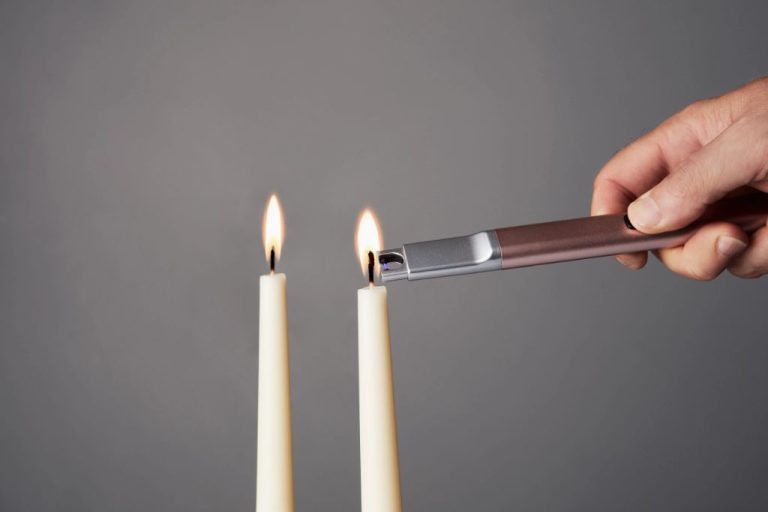What Is An Alternative To A Candle Lighter?
Candle lighters are small devices designed to help ignite the wick of a candle. They allow you to light candles easily and safely without having to use matches or a regular lighter. Some common types of candle lighters include long matchstick-style wand lighters, lighter sleeves that fit over cigarette lighters, and electric lighter devices.
While traditional candle lighters are convenient, they can have some annoyances. Wand lighters may require repeated clicks to produce a flame. Lighter sleeves may not fit all cigarette lighter sizes. Electric lighters need batteries and can be bulky. This is why many people look for handy alternatives to light candles safely.
In this article, we will explore some common household objects and tools that can be used in place of standard candle lighters to ignite candle wicks with ease.
Matches
Matches are a simple and commonly available alternative to using a candle lighter. To light a candle with matches, simply strike the match against the striking surface to ignite it and then hold the flame up to the candle wick until it catches fire and the candle is lit. Some pros of using matches instead of a candle lighter include:
– Matches are inexpensive and easy to find in any supermarket or convenience store.
– Matchboxes are highly portable so you can easily carry matches in your pocket or bag.
– Matches can be used to light other things besides just candles, like campfires, grills, etc.
Some cons to consider are:
– Matches have short lifespans when lit, so you need to hold them to the candle wick long enough for it to catch.
– Wind or drafts can blow out struck matches easily.
– Matches generate smoke when extinguished which can be unpleasant in close quarters.
– Matchboxes take up more space than compact candle lighters.
Overall, matches provide a quick, convenient way to get a flame source to light candles in a pinch. Just be sure to blow them out fully and dispose of used matches properly to avoid accidental fires.
Lighter
Using a cigarette lighter or any other type of portable lighter is another simple way to light candles. Many people have lighters readily available to light cigarettes, pipes, grills, etc. So a lighter can easily be repurposed to light candles.

To use a lighter, simply hold the flame up to the wick of the candle until it ignites. It’s best to keep the lighter an inch or two below the wick so you don’t burn or melt the wick before lighting it. The key is holding the lighter steady and in place until the wick catches the flame and starts burning on its own.
Lighters are very convenient and portable, making them an easy go-to for lighting candles. The main downside is that lighters eventually run out of fuel/fluid and need to be refilled or replaced. Butane lighters in particular tend to run out quickly with frequent use.
Toothpicks
Using toothpicks to light candles is a simple DIY method that takes advantage of friction. To use this technique, start by taking a regular wooden toothpick and rubbing the tip against a rough surface like concrete or sandpaper. Rub the tip vigorously in a back-and-forth motion to generate heat through friction. Keep rubbing until the toothpick tip turns dark and starts to smoke. At this point, the heated tip can be used to light a candle wick.
The main pros of using the toothpick method are that toothpicks and rough surfaces to rub them against are readily available in most homes. The materials needed are also inexpensive. Additionally, it doesn’t require any other tools or devices. The process itself is straightforward and can be done quickly.
On the downside, rubbing the toothpick by hand can be laborious and take some effort to generate enough heat. The toothpick tip can also easily break off during the process. Additionally, the friction method doesn’t work as well with plastic or coated toothpicks. For best results, unvarnished wooden toothpicks work best.
Spaghetti Noodle
Using an uncooked spaghetti noodle is an alternative method for lighting candles. To use this method, hold the tip of an uncooked spaghetti noodle over a candle wick. Light the other end of the spaghetti noodle on fire. The flame will travel down the noodle and light the candle wick once it reaches the tip.
The main advantage of using an uncooked spaghetti noodle is that it provides a long handle to keep your fingers away from the flame. This prevents burning yourself while lighting the candle. Spaghetti noodles are also inexpensive and available in most homes.
However, a potential downside is that holding a burning spaghetti noodle can be difficult without practice. The flame may go out before reaching the candle wick if not held steadily. The noodle can also break apart and drop hot ash on surfaces below. Proper caution should be taken when attempting this method.
Firestarters
Firestarters are items designed specifically to help start a fire. They are made out of very flammable materials that easily ignite from a spark or flame. Some common firestarter materials include wood shavings, cardboard, cotton balls, dryer lint, and wax-infused sawdust or wood chips.
Wood shavings, cardboard, and cotton balls are inexpensive and readily available options for DIY firestarters. Simply bundle up the flammable material into a small nest shape. The advantage of these is that they are free or very cheap if the materials are already on hand. The downside is that they burn quickly and may require multiple firestarters to get a fire going.
Commercial firestarters are also available for purchase. These are typically made from wax-infused sawdust, wood pulp, or wood chips compressed into shapes like cubes or chips. The wax helps the material burn longer. The advantage of commercial firestarters is that they are engineered to be very effective and consistent. The disadvantage is the added cost compared to homemade options.
Overall, firestarters provide a quick and reliable way to generate a flame for starting a campfire, fireplace, or candle. They are a preparation tool to make lightning fires easier compared to matches or lighters alone.
Electric Lighters
Electric lighters, also known as electronic arc lighters, are a type of lighter that uses electricity to create an electric arc to ignite whatever you want to light. They work by pressing a button or trigger which completes a circuit and generates an electric current across a small gap, creating a tiny lightning bolt or electric arc. This electric arc generates heat up to 1,300°C which is hot enough to easily light candles, cigarettes, or anything else you need to ignite.
Some pros of electric lighters are that they are reusable, windproof, and flameless. You don’t need any fluid like lighter fluid or butane to operate them, just batteries or a rechargeable battery pack. They can last for hundreds of ignitions before needing to be recharged. They are also safer than traditional lighters around kids or flammable substances since there is no open flame.
Some cons are that they may not work well at high altitudes or in very cold weather. The batteries can also lose power quickly if not charged properly. They tend to be a bit bulkier and heavier than disposable lighters as well. And while they don’t have an open flame, the electric arc can still burn skin or materials on contact. So care should still be taken when using them.
Light Bulb
One unconventional way to light a candle is by using a regular light bulb. The heat generated from an incandescent bulb can be enough to light the wick of a candle if placed close enough. Here’s how it works:
Position the light bulb 1-2 inches above the candle wick. Turn on the bulb and let it heat up for 30 seconds. Slowly lower the bulb towards the wick until it ignites. It may take a couple tries to get the positioning right. The key is getting the bulb close enough so that the heat is concentrated on the wick.
Using a light bulb has some advantages over traditional candle lighters:
- Light bulbs are inexpensive and easy to find.
- No open flame is required.
- You likely already have spare bulbs at home.
Some drawbacks to be aware of:
- It takes longer and requires more precision than regular lighters.
- Only works for lighting a single candle at a time.
- Incandescent bulbs run hot and pose a burn risk if handled incorrectly.
Overall, a light bulb can work in a pinch if you need to light a candle and lack a proper lighter. But for regular candle lighting, a long match, utility lighter, or butane lighter will be quicker and easier.
Magnifying Glass
Using a magnifying glass and sunlight is an old-fashioned yet effective way to light a candle. The key is focusing the sun’s rays through the magnifying glass onto the candle wick. As the rays concentrate, the heat intensifies and ignites the wick.
The pros of using a magnifying glass are that it’s a renewable, natural source of energy and heat. Magnifying glasses are also inexpensive and easy to find around the house or purchase. They provide a fun, educational lighting method for children to grasp basic scientific principles.
The cons are that magnifying glasses only work on sunny, clear days. Cloudy or rainy weather makes lighting a candle this way impossible. It also takes practice to angle the magnifying glass correctly to focus the rays. Moving or windy conditions outside can disrupt the process. Overall, while novel, magnifying glasses are less convenient and reliable than many modern lighters.
Conclusion
There are several effective alternatives to using a traditional candle lighter. Matches, lighters, toothpicks, dry spaghetti noodles, firestarter blocks, electric lighters, light bulbs, and magnifying glasses can all be used in various ways to light candles safely and easily.
Of all the options, matches and long fireplace matches are likely the simplest and most accessible for most people. They are inexpensive, widely available, and specifically designed to produce a flame. Lighters are also very convenient and reusable, though some caution should be used around open flames. For those looking for more unique or makeshift solutions, using dry spaghetti, toothpicks, or a magnifying glass to concentrate sunlight can work in a pinch.
Overall, standard matches are recommended as the best alternative for lighting candles. They are affordable, easy to use, and sold everywhere candles are sold. With proper care, matches provide a simple, reliable way to safely light candles.



